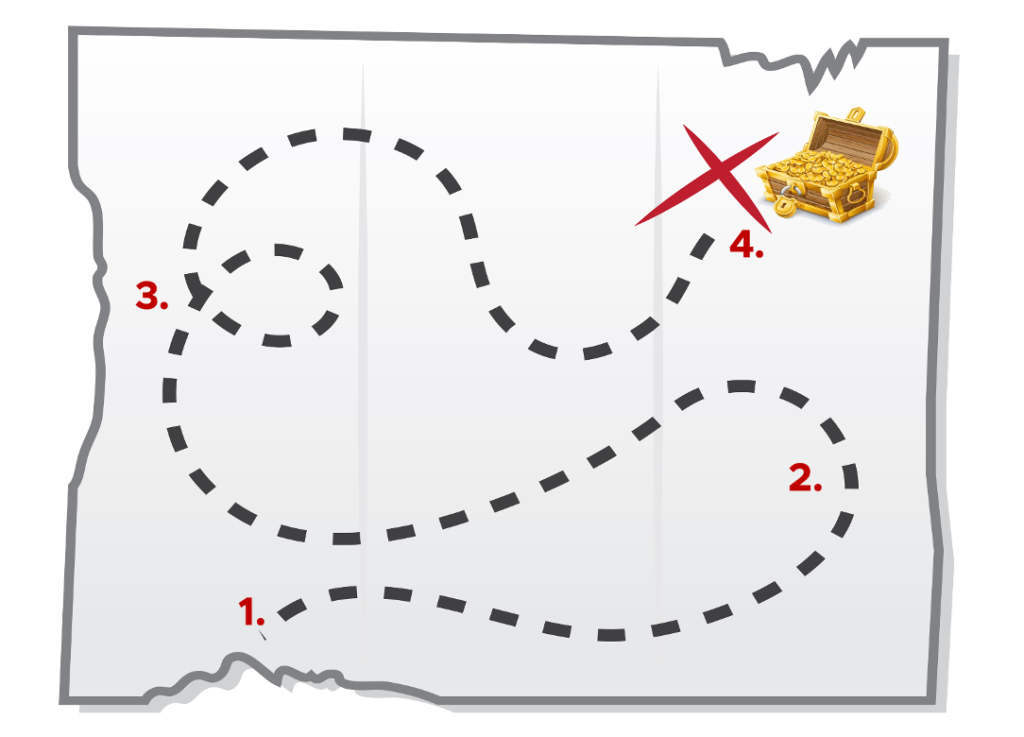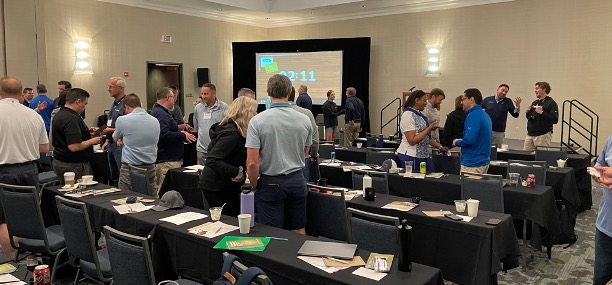One of the most powerful tools you have for developing your team are 1:1 meetings.
Regular 1 on 1 meetings are an effective tool for building relationships, tracking progress and providing coaching insights that help team members achieve their goals.
And they don’t have to be in-person…
You can lead a remote or hybrid team and do a fantastic job of having 1 on 1 meetings with your people – and using those interactions to significantly improve team performance.
These meetings provide an opportunity for both parties to discuss progress, goals, concerns, and feedback, which ultimately leads to increased employee engagement and productivity.
In fact, Harvard Business Review has reported that “employees who got little to no one-on-one time with their manager were more likely to be disengaged. On the flip side, those who get twice the number of one-on-ones with their manager relative to their peers are 67% less likely to be disengaged.”
And while the average professional is scheduled to attend around TWENTY HOURS OF MEETINGS each week, the impact of successful 1 on 1 meetings would suggest that you cannot neglect the opportunity they provide you.
In terms of frequency, research has suggested that the greatest percentage of surveyed employees wanted weekly meetings – but whatever the cadence that you can accommodate, it is vital to begin scheduling them with your people.
However, it’s not enough to simply schedule a 1:1 meeting and hope for the best.
To get the most out of these meetings, managers must have a clear structure and template in place to guide the conversation.
In this article, I’ll outline why 1:1 meetings are so important.
And I’ll give you a template for structuring these meetings, as well as a downloadable document with specific connection questions you can use.
Importance of Effective 1 on 1 Meetings
1:1 meetings are an essential part of effective leadership and management for several reasons.

Firstly, they provide an opportunity for managers to check in on their team members’ progress towards goals and provide feedback on their work. This feedback can be both positive and constructive and can help employees understand where they stand in terms of performance and what they need to work on.
Secondly, 1:1 meetings create a space for open and honest communication between managers and employees.
By providing a safe environment where employees can express their concerns, challenges, and ideas, managers can gain valuable insights into what is happening in their team and make informed decisions based on that feedback.
Finally, 1:1 meetings demonstrate to employees that their manager cares about their personal and professional development. By taking the time to have regular meetings, managers show their team members that they value their contributions and want to help them succeed.
Structure of 1 on 1 Meetings –
To make the most of 1 on 1 meetings, it’s important to have a clear structure in place.
- Scheduled every week (if you aren’t leading WEEKLY, you are leading WEAKLY!)
This needs to be a priority for you, as it will be the way that you manage and GROW your people.
Put it on your calendar as a recurring meeting (preferable on Tue or Wed to ensure they are kept and are easily rescheduled if needed).
This will also give you BACK MORE TIME as people will come to you for minor items less often when they know they have time with you during 1:1 meetings each week.
- 30 minutes long (10 for their stuff, 10 for your stuff, 5 for future stuff)
Less than this, and you won’t be able to cover everything you may need to.
More than this and it becomes difcult to keep on your calendar.
And early on, you may find that your people take MORE than the allotted 10 minutes to share THEIR STUFF – and that is okay. Your job is to set up a space where they are comfortable airing out issues and sharing their concerns and challenges (professional and personal) so you can lead more effectively with that information.
Over time, you will be able to use YOUR 10 minutes for more targeted feedback…
FOLLOW THIS CONVERSATIONAL PATH:

1. – CONNECTION
Open with a question to give THEM control (“What’s on your mind?”)
Begin the meeting by allowing THEM to focus on what is important to THEM.
Asking about their family may actually hijack the focus. So let the other person choose to share how they are doing, both personally and professionally.
IF you are just starting or new to your role, then you will definitely want to establish some familiarity and awareness of their life and situation and preferences… but later in your meetings, let them set the agenda early.
Over time, they will realize that you care about them as a person, not just as an employee.
(Be sure to take notes and maintain a record that you can circle back to review)
2. – CHALLENGES
Review the employee’s progress towards their goals since the last meeting. Celebrate successes and provide constructive feedback on areas where they could improve.
Talk to the employee about their career aspirations and how they see themselves growing within the organization. Provide guidance on how they can achieve their goals and offer opportunities for growth and development.
Share any feedback about strengths or concerns:
This is the part of the conversation where you can share what they are doing well, and be specific about their impact on the team’s success and progress.
Here is where you may at times need to share things THEY have not noticed that are affecting team performance. This is where you could have a meaningful POINT feedback conversation.
Not required for every conversation, but it is in 1:1 meetings that you can also address opportunities for personal growth and help overcome any issues.
3. – CLARITY
Clarify what THEY THINK would be positive next steps
This is a collection of conversational topics that you will want to be fully invested in so that you are LISTENING to understand and support the person you are meeting with.
Ask for their ideas on what productive next steps and actions might be…
That is what will have the most positive influence on your relationship.
4. – COMMITMENTS
Use the last few minutes for coaching and future focus
Close with a summary and action items:
Summarize what was discussed during the meeting and identify any action items that need to be taken. Set a date for the next 1:1 meeting and follow up on any action items as needed.
Be sure you have identified who will do what by when…
And Thank them for their time, honesty, and efforts!

Consistency Creates Growth
The ONE thing that is most important about your 1 on 1 meeting with team members is YOUR COMMITMENT to have them regularly – EVERY WEEK.
You MUST place these on your calendar and protect them.
The value and impact that these 1 on 1 meetings can have should inspire you to place them on your calendar, to protect them on your calendar, and to prioritize them as part of your effort to build a more positive and profitable workplace culture.
One major problem is that nearly 40% of managers report rescheduling one-on-ones weekly.
If you don’t treat them as valuable, your team members will begin to see their challenges and relationships and development as less important – and will become less engaged and productive when they feel they are less of a priority.
1:1 meetings are a vital component of effective leadership and management, and are part of helping create the loyalty anchors that will retain your top talent and develop others into valuable contributors.
By providing a space for open and honest communication, managers can build strong relationships with their team members and help them achieve their personal and professional goals.
If you would like an easy-to-use set of questions that you can have ready during these conversations, you can download my 1 on 1 Teammate Meeting Framework Form!
Checklist for Effective 1 on 1 Meetings:
__ – be prepared (keep your notes in a folder to review beforehand)
__ – remind the person a day or two before to bring things with them to discuss
__ – expect a bit of awkwardness in first meeting or two (it WILL pass)
__ – keep the spotlight on them and their needs, challenges, goals
__ – listen well, take notes, and clarify their words to ensure understanding
__ – schedule next meeting before ending this one (meet regularly!)
__ – follow-up afterwards with a short review and reminder of items for accountability
__ – be patient… 1:1 meetings will eventually have a tremendous impact on your team!
Final Thoughts…
In every teamwork keynote I deliver, I share that leaders can improve team performance by having regular 1:1 meetings with team members to discuss goals and progress. These meetings provide an opportunity to review performance metrics, identify areas for improvement, and provide coaching insights.
During these 1:1 meetings, leaders can provide feedback on performance and offer guidance on how team members can improve. This coaching approach can help team members feel more supported and empowered to take ownership of their work. It can also help leaders identify potential issues before they become major problems.
By using the template outlined in this article, your 1:1 meetings will be more productive, efficient, and beneficial for both parties involved.
– – – – –
Sean Glaze is an engaging business leadership speaker and interactive team building events facilitator who helps organizations develop more effective leaders and build more positive and profitable workplace cultures.
Sean is the author of four books, The Unexpected Leader, Rapid Teamwork, The 10 Commandments of Winning Teammates, and Staying Coachable – each one an entertaining parable with powerful take-aways for team growth and leadership!
What issues are YOU dealing with that would disappear if you could build a team culture that inspired connection, accountability, and a team-first attitude?

Use Connection Chats to Engineer Better Collaboration Across Every Division on Your Team

Effective Leaders Build Trust and Teamwork by Focusing on Leadership Development

The Power of a Sticky Culture in Boosting Organizational Performance and Retention

Are Your Team Standards Seen as Suggestions or Recognized as Requirements?
Books and Resources for Leaders
Check other blog
Use Connection Chats to Engineer Better Collaboration Across Every Division on Your Team
Effective Leaders Build Trust and Teamwork by Focusing on Leadership Development
The Power of a Sticky Culture in Boosting Organizational Performance and Retention
Contact Sean

Connect with Sean

Tell Sean About
Your Event
Tell Sean About
Your Event
"*" indicates required fields













